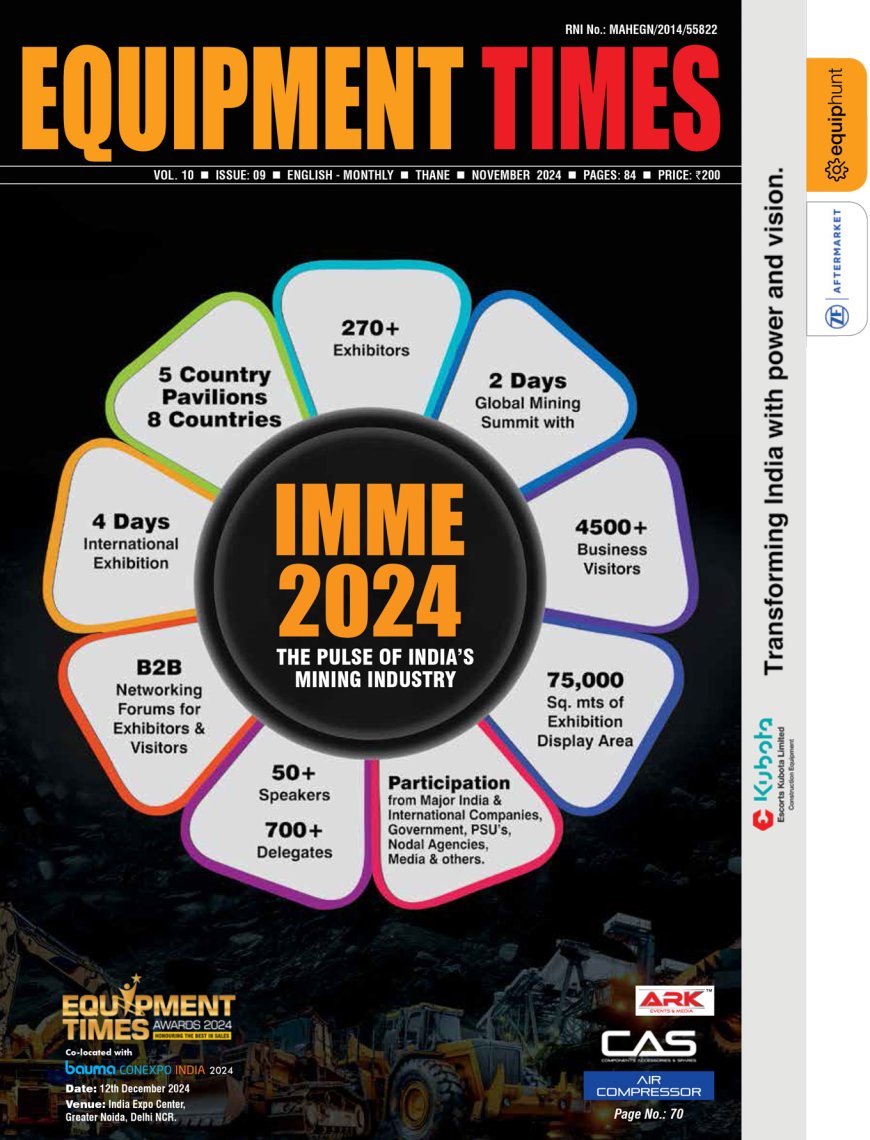POISED FOR ACTION!
With the after effects of COVID pandemic, road construction machinery market was seeing a halt in sales, nevertheless, the road construction industry is getting smarter with improved digitalization and connectivity. Equipment Times looks at the trends, intelligent solutions and road

With the after effects of COVID pandemic, road construction machinery market was seeing a halt in sales, nevertheless, the road construction industry is getting smarter with improved digitalization and connectivity. Equipment Times looks at the trends, intelligent solutions and road map after the sector resumed its road and construction activities, indicating positive growth rate for the year.
The increasing focus on infrastructure and development of highways and expresses has a significant impact on the growth of the road construction machinery market. The road construction machinery market has witnessed significant growth in the recent past due to the increased road development programs undertaken by the central and state governments.
Also, the demand for machines that are cost-effective, along with regulatory pressures for lower emissions, is pressurizing construction-equipment manufacturers to opt for electric and hybrid vehicles over the traditional hydraulic and mechanical ones.
The rising cost of purchasing equipment, increasing economic uncertainty, lack of capital, technology up-gradation, unpredictable construction and infrastructure growth, depreciation woes, costly breakdowns, and limited space availability, are some of the factors that are hindering the market growth. Although, due to the high purchasing cost associated some of the equipment, smaller construction companies prefer using rental services and second hand road construction machineries.
In 2020, with the effect of COVID 19 pandemic, road construction machinery market had seen a halt in sales, nevertheless, the road construction industry is now getting smarter with improved digitalization, connectivity, and with the government resuming its road and construction activities, indicating positive growth for this segment.
India is experiencing an increase in road development programs undertaken by central and local governments. With the growing urban population, there is a higher demand for smart cities and mounting pressure on existing municipal services such as public transport and road networks. The concrete paved road also helps reduce the vehicle’s fuel consumption. Factors such as these are expected to boost the demand for road construction equipment.
The Indian Ministry of Road Transport and Highways has already announced large-scale expressway projects to enhance connectivity, boosting the country’s infra sector. These include Purvanchal Expressway, Delhi-Mumbai Expressway, Mumbai-Nagpur Super Communication Expressway, and Bangalore-Chennai Expressway. State-level projects are also being planned to improve road connectivity across the nation. In 2018, the Eastern Peripheral Expressway (EPE), Western Peripheral Expressway (WPE), and phase 1 of Delhi-Meerut Expressway were also launched.
Future demand looks robust : Off-Highway Research…
According to Samir Bansal – General Manager, Off-Highway Research, the road sector has been a major driver for construction equipment sales in India for the past five years as major road network development projects are being undertaken in the country. “The future demand also looks robust as huge investment outlay of Rs.20,338 billion is envisaged for roads sector in NIP. Covid-19 impacted the road equipment demand during March-June 2020, which started recovering rapidly thereafter and reached peak sales levels by end 2020. However, overall demand for construction equipment still fell 12 per cent to 73,593 units in 2020, which is expected to grow 15 per cent in 2021 and will peak at over 108,000 units by 2025,” Bansal said.
He further added, “The new emission regulations effective from April 2021, will upgrade emission standards for all wheeled equipment that are registered with the transport department from the present Bharat Stage III to CEV-IV. It may have a temporary negative impact on sales, which is expected to even out on annual basis. Demand for all major road construction equipment asphalt finishers, backhoe loaders, compaction equipment, crawler excavators, motor graders and wheeled loaders is expected to grow steadily during the next five years except for a dip in 2024 due to elections.”
Greenfield Expressways…
Greenfield Expressways in India are designed as 12-lane Expressways with initial construction of 8-lanes. Land for 4-lane future expansion is reserved in the center of the expressways. Greenfield Expressways are designed to avoid inhabited areas and go through new alignments to bring development to new areas and to reduce land acquisition costs and construction timeline. Delhi-Mumbai expressway is a great example of new 12-lane approach with initial 8-lane construction.
The majority of the investment required for constructing expressways comes from the Central Government. Uttar Pradesh and Maharashtra are the only states which are investing in building expressways through dedicated expressway corporations.
The National Expressways Authority of India (NEAI) operating under the Ministry of Road Transport and Highways will be in-charge of the construction and maintenance of expressways. The National Highways Development Project by the Government of India aims to expand the country’s current expressway network and plans to add an additional 18,637 km of greenfield expressways by 2022 apart from existing national highways.
Demand for Intelligent machines…
In the construction sector, the demand for intelligent equipment is increasing tremendously, owing to the increase in the number of projects. “An intelligent machine will lift the overall performance of the equipment, making the operation on the most difficult sites easy and efficient. According to Gartner, given the recent trends in tech and especially the acceleration of AI, by 2023 AI will be one of the top workloads that drives infrastructure decisions, and this is propitious for the construction industry, says Sandeep Mathur, Brand Leader – CASE India.
He further added, “Currently, industry 4.0 is bringing a revolution in the country. Industry 4.0 will simplify the day to day work. According to a report by Mckinsey, by harnessing industry 4.0 tools like IoT, AI and automation, processes will see 30 to 50% reduction in machine downtime; 15 – 30% improvement in labour productivity; 10 to 30% increase in throughput; and 10 to 20% decrease in the cost of quality. Industry 4.0 will enable us to decrease dependency on labour and create smart and intuitive products for the future with higher efficiency and productivity and low downtime.”
According to Ramesh Palagiri, Managing Director & CEO – Wirtgen India, “In India, Government has laid a foundation of digitization in road construction with its ‘Digital India’ mission and various other schemes. The Ministry of Road Transport and Highways (MORTH) is encouraging the implementation
of a ‘Value Engineering Program’ to promote the use of new, emerging and advanced technologies.”
Speaking about the trends in road construction equipment technologies, Palagiri said, “Customer demand for better, more efficient and cotemporary products will not go away. We have in fact increased our R&D budget to make sure we are ready for future. Most construction equipment has to upgrade to next level of emission norms in next couple of years.”
Nitesh Jahangir of Secmair-Breining (FAYAT Group) India & South East Asia, said, “In India market, we offer slurry pavers also known as micro surfacing machine, cold emulsion pothole repair machine and road crack sealing equipment. There are more than 20 micro surfacing machines working on different project sites across India enhancing the pavement life and making roads safe for the users.”
Highways Construction touches record 34 km a day…
The Ministry of Road Transport and Highways (MoRTH) has exceeded the target for highway construction for fiscal year 2021 despite the ongoing pandemic that led to a lockdown during the year, it said in a statement.
MoRTH has constructed 12,205.25 km of national highways till 22 March 2021 in the current financial year, clocking a construction of 34 kilometres per day. “This is also 1,205 km more than the target (11,000 km) fixed for the current fiscal,” the ministry said in the statement.
“This is almost three times the rate of construction of highways of about 12 km per day in 2014-15,” it added.
This achievement is significant as the first few months of the current financial year were lost due to nation-wide lockdown in the wake of covid-19 pandemic, the ministry said in the statement, and added that construction activities were badly affected during the period.
Union Road Transport and Highways minister Nitin Gadkari had earlier in March announced achieving the target of constructing 11,000 km of national highways, one month ahead of schedule.
The achievement assumes significance given the fact that the first two months of the current financial year were lost due to the nationwide lockdown in the wake of COVID-19 pandemic.
The ministry has taken several initiatives to increase the pace of construction. The pace of construction is expected to increase further in the remaining months of the current financial year, which are conducive for construction activities.
Plans to monetize toll roads for further development of road infrastructure: Nitin Gadkari
Addressing the inaugural session of the CII National Conference on Roads Infrastructure: Creating Demand-Stimulating Growth, organized by CII, the Minister for Road Transport & Highways, and MSME, Nitin Gadkari said, “Every rupee spent on infrastructure translates to 2.5-rupee growth in the economy. It is our firm belief that increased investment in infrastructure would not only create demand in the economy but also and more importantly it would make growth sustainable, equitable and inclusive.”
He further added that Ministry of Road Transport and Highways aims to increase the pace of construction of highways from 35 km per day at present to 40 km per day soon. The Ministry also plans to raise Rs 1 lakh Cr by monetizing toll roads and use the fund for further development of road infrastructure.
He said that in the larger interest of the nation, there was a need to take the load of traffic off-the-road. At present 85 percent of transit is through the roads. Government is making efforts to increase traffic shares of Inland waterways, Rail and Air to balance the flow and expand mobility. The Minister also mentioned about the Government’s focus on alternate fuels and investment in Li-ion, Hydrogen technology. The automobile sector currently contributes 7.5 lakh crore to the GDP which could up to Rs. 10 lakh crore leveraging alternative fuel and clean fuel technology which has huge potential to create jobs. He insisted that there is a need for private sector to invest in R&D.
Representing CII, Vinayak Chatterjee, Chairman, CII National Council on Infrastructure and Chairman, Feedback Infra made three poignant suggestions; Firstly, use Blockchain technology for bringing in transparency in submission and tracking of invoices; second, use Surety Bonds as an alternate to Bank Guarantees (BGs), and third, have a highway rating mechanism on certain parameters such as driveway quality, amenities, safety, etc, by a professional agency and link it with incentives / disincentives to toll operator.
Speaking at the session, Deepak Shetty, Chief Executive Officer and Managing Director, JCB India spoke about the optimistic growth that the construction equipment sector has seen and said India needs to continue to invest in technology to maximise the potential this sector can bring in. He also emphasized on the need for sustainable development of the construction sector.
Chairing the Inaugural Session, Chandrajit Banerjee, Director General, CII appreciated the efforts of the government of India to build a world class infrastructure in the country. He highlighted several initiatives, including launch of National Infrastructure Pipeline of Rs 111 lakh cr; Asset Monetisation Programme and a dashboard for tracking the progress to provide visibility to investors, setting up a development finance institution, etc. as an example of Government unflinching commitment to build a highly efficient and cost effective infrastructure in the country. He further stated that investment of this magnitude offers a huge opportunity in terms of embellishing demand, generating jobs and laying a foundation for creating an Aatmanirbhar Bharat.
Hits: 214











